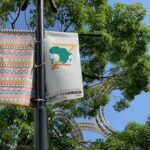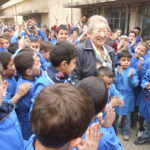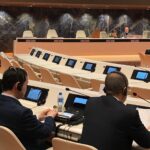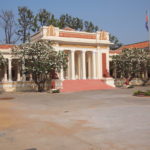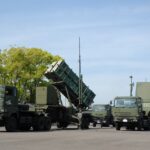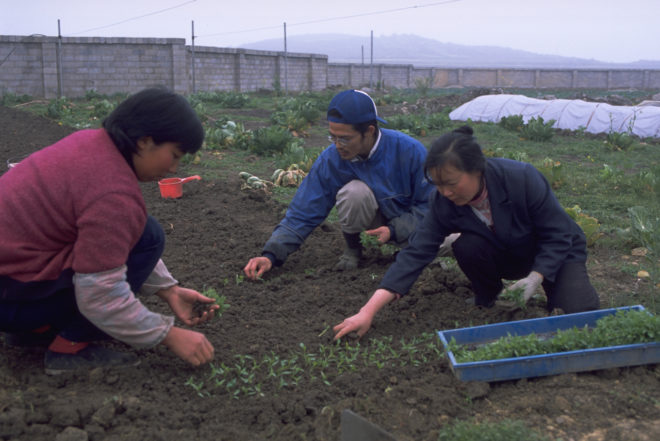
JICA has been dispatching Japan Overseas Cooperation Volunteers (JOCV) to China since 1986. Pictured, a JOCV member (blue hat) teaches vegetable farming techniques to Chinese farmers in Guizhou Province.
COURTESY OF YOSHIDA KATSUMI/JICA
In 1978, forty years ago today, Japan and China concluded the Treaty of Peace and Friendship between Japan and the People’s Republic of China to strengthen and develop their bilateral peaceful and friendly relations. In 1979, Japan began providing official development assistance (ODA) to China. Since then, Japan has provided a total of more than 3 trillion yen in ODA via a range of schemes, including ODA loans, grant aid and technical cooperation.
Japan’s ODA to China has changed in accordance with Chinese social and economic needs. In the 1980s, Japan supported large-scale infrastructure development projects, such as ports, railroads, power stations and roads, with ODA loans. In addition, the Japan International Cooperation Agency (JICA) provided technical cooperation in a range of areas, including agriculture, health and electric communications. In 1986, JICA began sending Japan Overseas Cooperation Volunteers (JOCV) to China, and in 1987, JICA launched a project that involved inviting Chinese young people to Japan. (Current Prime Minister Li Keqiang also visited Japan in 1988 and 1990 as part of this project.)
Because environmental problems such as air and river pollution became more serious in China in the 1990s due to its rapid economic growth, many projects related to environmental preservation began to be implemented. As part of these projects, the Sino-Japan Friendship Center for Environmental Protection was established in 1996 with the support of grant aid (Its technical cooperation was started from 1992). In addition, because Chinese domestic economic gaps were spreading, more projects for tackling poverty were implemented in local areas where before they were not the main ODA target areas, such as urban areas including Beijing and Shanghai and northeastern areas.
After 2000, projects for measures for infectious diseases and measures for the aging society and legal formulations for the healthy development of the market economy as well as measures for environmental problems were implemented mainly through technical cooperation. (Acceptance of new ODA loan requests ended in 2007.)
“Japan’s ODA can be said to have made a significant contribution to Chinese economic development,” says Fujiya Koji, Director General, East and Central Asia and the Caucasus Department of JICA. “JICA has sent numerous experts and volunteers to China as part of its technical cooperation in order to develop human resources and transfer techniques. This cooperation is evaluated highly by Chinese people.”
Sino-Japan Friendship Hospital
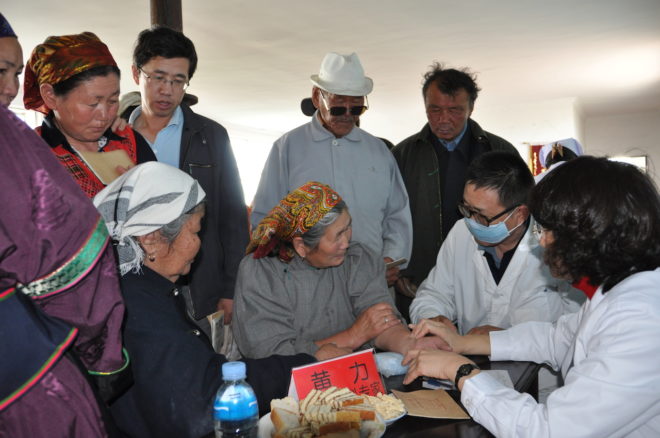
Doctors and nurses of the Sino-Japan Friendship Hospital conduct free medical activities as a JICA Alumni activity in poor farming villages.
COURTESY OF JICA
JICA’s technical cooperation in China started with the Project of Technical Cooperation for Sino-Japan Friendship Hospital. In the late 1970s, China decided to establish a hospital that aimed to integrate Western medicine and traditional Chinese medicine, and asked Japan to support it. In response to this request, the project commenced in 1981 in line with building a hospital using grant aid. In this project, numerous Japanese doctors and nurses traveled to China and shared multiple techniques, such as operations, examinations, diagnosis and how to write clinical records. In addition, JICA also invited Chinese medical-related people to Japan to conduct training programs. In 1984, the Sino-Japan Friendship Hospital, which was equipped with the latest Japanese medical equipment and facilities at the time, opened in the suburbs of Beijing. Subsequently, JICA continued to provide technical cooperation until 1995. JICA sent a total of 166 experts and 14 JOCVs to this hospital and accepted 234 participants in Japan.
Through this cooperation between Japan and China, the Sino-Japan Friendship Hospital became a leading Chinese hospital. When severe acute respiratory syndrome (SARS) spread throughout China in 2003, it was designated as a hospital for treating patients suffering from SARS, and it accepted and treated many patients. In 2008, it was designated as a special Beijing Olympic Games hospital and diagnosed numerous athletes and coaches from all over the world. In addition, the hospital developed medical human resources in China.
“The Sino-Japan Friendship Hospital also works as the Secretariat of the JICA Alumni Association in the area of medicine and health. Alumni members conduct free medical activities in disaster-affected areas and poor farming villages every year,” says Fujiya. “They also undertake exchanges with Japanese medical universities and maintain their relationships with Japan today as well.”
Eradicating Polio
JICA’s technical cooperation in the area of health and medicine has produced significant results in terms of measures for combating infectious diseases. One of these is the Polio Countermeasures Project, which was launched in 1991. In this project, JICA provided vaccines and cold chains, built nationwide networks for polio testing room diagnosis and provided support for the development of human resources as measures for preventing the polio infections that were raging in China at the time. In 2000, after the project had ended in 1999, the World Health Organization (WHO) declared that it had eradicated polio in the Western Pacific region, including China.
Subsequently, JICA conducted the Project for Surveillance and Control for Vaccine-Preventable Diseases from 2006 to 2011. In this project, which was conducted in five central and western provinces and autonomous regions, including the Province of Jiangxi and the Province of Sichuan, JICA set the goal of obtaining information on people who had not been vaccinated and improving the accuracy of infectious disease diagnosis examinations to maintain the polio-free situation and reduce the outbreak of measles, Hepatitis B and Japanese encephalitis, and carried out various kinds of activities. For example, JICA took action to discover which children had not been vaccinated among children who entered kindergarten and elementary school. In China, vaccination records are entered on vaccination certificates that are issued to each child. When parents follow the procedures for their children’s entry to kindergarten and elementary school, their vaccination certificates are required to be checked. In the project, JICA drew up manuals on how to check the vaccination certificates and how to address a problem on the basis of the opinions of teachers who would check the vaccination certificates and provincial, city and county health officials. In addition, JICA also implemented training programs for the teachers at kindergartens and elementary schools and people associated with the vaccination projects using the manuals.
“In the polio project of the 1990s, Japanese experts even worked in areas that foreigners had difficulty entering at that time. I think that the Chinese people put their trust in Japanese experts to a significant extent,” says Fujiya. “It can be said that our polio project also contributed to nurturing human resources for surveillance and to building a health and medical system for measures against infectious diseases such as HIV/AIDS and SARS, in later years.”
Support for Afforestation
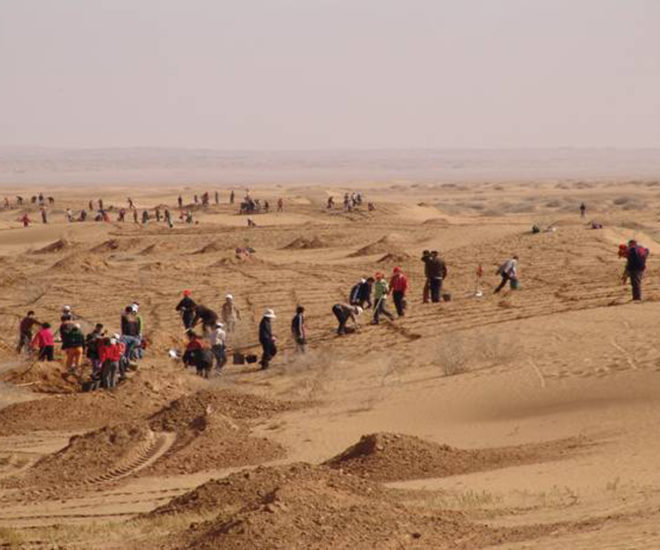
Japan supports afforestation efforts in China — such as the Gansu Afforestation and Vegetation Cover Project pictured — with ODA loans, technical transfers and training programs.
COURTESY OF JICA
JICA also provides a range of support for forestry. In China, the quality of the land has declined and desertification has progressed for many years due to the population increase, excessive pasturage and the cultivation of agricultural land. In recent years, however, the Chinese government has actively promoted afforestation, and forest areas have increased significantly. To back this up, Japan has also provided support for afforestation, measures for desertification and the preservation of biodiversity. Japanese NGOs, local governments and volunteers as well as JICA participate in these activities.
One of the areas in which Japan provides intensive support is the Loess Plateau, which is located in northwestern China and stretches along the mid- and upstream of the Yellow River. The Loess Plateau, which has an area of around 600,000 square kilometers, is affected by significant natural disasters, including yellow sand, desertification, the outflow of surface sand and drought, and many people in this area are facing poverty. From 1990 to 1995, JICA conducted the Watershed Management Training Project on the Loess Plateau in China, and experts who were sent to the area conducted technical transfers to prevent soil erosion and restore barren land. From 2001 to 2010, afforestation projects were conducted in the Province of Shanxi, the Province of Shaanxi and the Inner Mongolia Autonomous Region with ODA loans. These ODA loans were used to procure seedlings for developing protective forests and orchards, and contributed to improving the afforestation rate of the Loess Plateau and farmers’ incomes. In addition, from 2010 to 2015, JICA conducted the Dissemination of New Forestation Technology in Loess Plateau. In this project, JICA supported to improve and promote forestry techniques and management methods suited to the Loess Plateau through training programs for people who engage in forestry in the provinces and autonomous regions in the Loess Plateau.
Support for the victims of the Great Sichuan Earthquake of 2008
On May 12, 2008, a massive earthquake with a magnitude of 8.0 struck Wenchuan County in the Province of Sichuan, China, causing serious damage and leaving more than 80,000 people dead. Japan sent the rescue and medical teams of the Japan Disaster Relief Team (JDR) to the earthquake-hit area. The rescue team failed to find any survivors. But media reported that the team members offered a silent prayer for a disaster victim who had been discovered beneath the debris, which moved and touched the Chinese nationals very much.
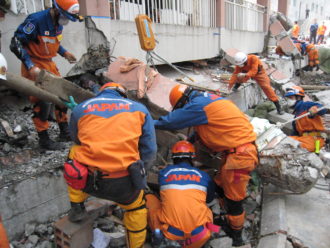
Members of the Japan Disaster Relief Team (JDR) search for victims following the Great Sichuan Earthquake of 2008.
COURTESY OF JICA
Subsequently, Japan continued to conduct activities in a wide range of areas to support reconstruction of the earthquake-hit areas and improve the capability of disaster management. As one of them, from 2009 to 2013, JICA conducted the Japan-China Cooperation Plan of Earthquake First-aid Capacity Training. One pillar of the project was to improve the skills of provincial government administrators who would take charge of emergency operations in the event of a disaster. The Chinese government has the National Earthquake Response Support Service (NERSS), which conducts rescue and emergency support activities in the event of a major disaster. NERSS conducts drills for provincial government administrators who take emergency measures. In the project, Japanese experts who were sent to China, including university professors and the public officials of local governments in charge of disaster measures, instructed Chinese instructors or invited Chinese instructors to Japan for a training program. These instructors worked to improve their emergency skills through practical exercises, such as the Time Schedule Drill as an Emergency Measure for Disasters, which shows a time schedule for emergency measures in the event of a disaster, and the Map Simulation, which is used for simulating the actions taken by the disaster measures headquarters.
Another pillar of the project was to strengthen the emergency rescue capability of JDR. JICA sent Japanese firefighting and rescue experts to the National Earthquake Emergency Rescue Exercise Base in the suburbs of Beijing and provided technical instructions to the instructors working at the base. For example, the technical instructions included the technique of handling tools, such as engine cutters and drills, triage, the technique of classifying those injured according to the degree of injury and the level of emergency and deciding on treatment priorities, and how to prevent crush syndrome, which is a situation where, after a person has been trapped under a heavy object for many hours and is rescued, his/her condition suddenly changes, resulting in death.
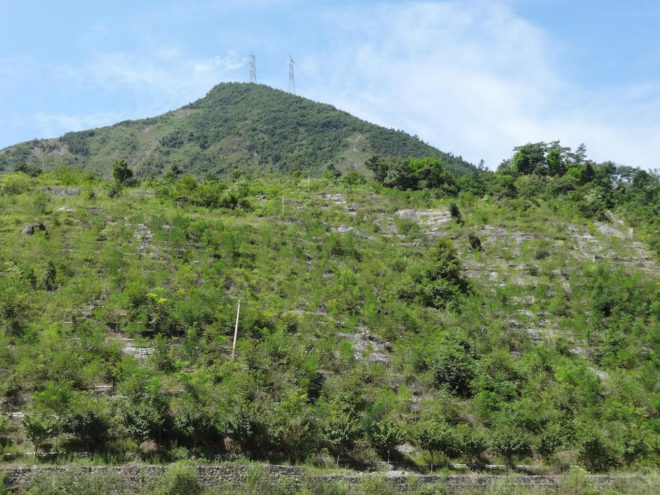
JICA has supported forest restoration in Sichuan through the Project on Forest Restoration after the Earthquake in Sichuan Province (2010–2015).
COURTESY OF JICA
JICA also undertook technical cooperation, such as the Human Resource Development Project for Seismic Engineering and Construction of Buildings (2009–2013), Project for Capacity Development on Mental Health Services for Reconstruction Support of Sichuan Earthquake (2009–2014), Project on Forest Restoration after the Earthquake in Sichuan Province (2010–2015) and Project for Promotion and Capacity Development of Disaster Mitigation Education in Sichuan Province (2015–2018).
The Future of Cooperation between Japan and China
Around forty years have passed since Japan began providing ODA to China. China has developed into a country with the second-highest GDP in the world, and it is now an important market for Japanese companies. Currently, JICA is focusing on solving issues that are common between Japan and China, utilizing the techniques of private companies, and on technical cooperation that yields benefits to both countries. For example, it includes the China-Japan Cooperation Project on Measures for the Aging Society, which will be conducted from 2016 to 2020. Today, the rate of Japan’s population aging (the rate of people aged 65 and older to the entire population) is 27%. To cope with the aging society, Japan formulates laws, nurtures human resources, and researches and develops products for elderly people. China is also facing rapid population aging, and the population of people aged 60 and older is projected to reach the benchmark of 300 billion in 2025, up from 210 million in 2014. In the project, JICA conducts a training program in which Chinese people in charge of measures for population aging visit Japanese government organizations, local governments, universities, companies and facilities for elderly people to study the nursing care system and how to nurture human resources for nursing care and welfare products, or Japanese experts conduct hands-on investigations of Chinese measures for population aging.
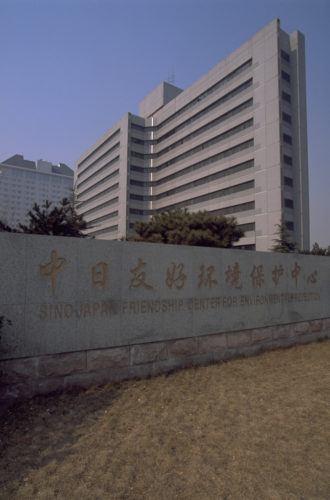
The Sino-Japan Friendship Center for Environmental Protection in Beijing, China. The Center was established in 1996 with the support of grant aid from Japan, which has offered technical cooperation through JICA since 1992.
COURTESY OF JICA
In addition, JICA is also conducting the Project for Environment Friendly Society Building from 2016 to 2021 in cooperation with the Sino-Japan Friendship Center for Environmental Protection. In China, there has been a rapid increase in air-polluting substances and greenhouse gas emissions due to rapid industrialization and urbanization, and river pollution is also getting worse. In Japan, too, pollution became a serious social problem during its period of fast-paced economic growth from the 1950s to the 1970s. But Japan implemented legal formulations, legal executions and technical developments and finally improved pollution levels significantly. Based on these experiences and techniques, JICA implements measures in the project that include the formulation of policies and legal systems and the promotion of techniques for preventing environmental pollution and helping citizens and public administrators to raise their awareness.
“Good Japan-China relations yield benefits to both countries,” says Fujiya. “Japan’s ODA programs, which have been implemented for about forty years, prompt a wide range of human exchanges, which have contributed to building mutual trust. It is important that we strategically continue to utilize these assets for good Japan-China relations.”
SAWAJI Osamu, The Japan Journal



